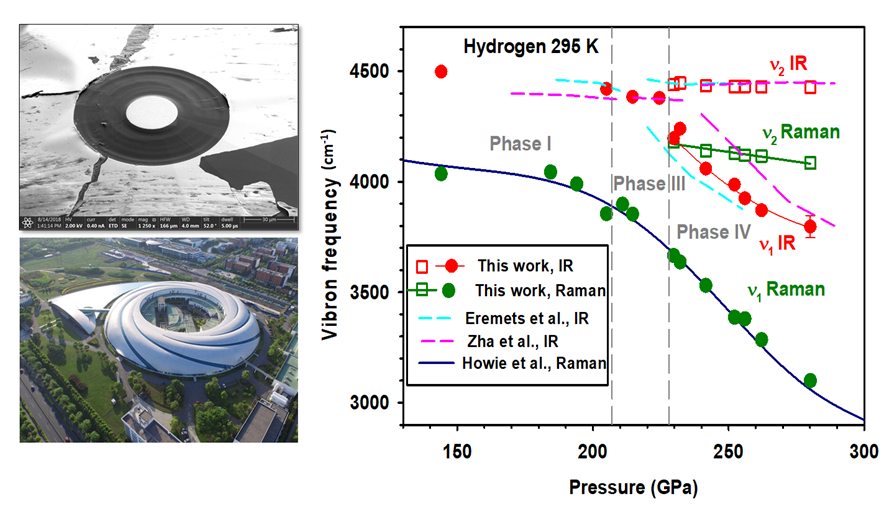Combined concomitant IR-Raman measurement on hydrogen phase IV - Drs. Cheng Ji and Ho-kwang Mao
DECEMBER 3, 2019
New study from a team of scientists co-led by Dr. Cheng Ji and Dr. Ho-kwang Mao from HPSTAR performed the first combined infrared-Raman experiments on hydrogen phase IV, up to 280 GPa. By utilizing an advanced spectroscopy system which incorporates synchrotron Infrared (IR) spectroscopy and Raman spectroscopy at Shanghai Synchrotron Radiation Facility and toroidal diamond anvils, they revisited phase IV in its molecular symmetry and revealed heterogeneous and fluxional behaviors. The study has been published in the recent issue of PNAS.
Phase IV of hydrogen was discovered in 2012, which was suggested to possess a crystal structure bearing ‘mixed molecular-atomic’ features. Based on spectroscopic data, theoretical calculations explained this phase by the presence of two distinct molecules — elongated molecules in graphenelike layers and shortened molecules in quasihexagonal layers. Intermolecular interactions of these two types of molecules are supposed to be different.
To quantify the intermolecular interactions in phase IV, concomitant IR and Raman measurements are desirable to eliminate the pressure uncertainty between measurements performed on different samples. For this purpose, The team developed such a system to combine synchrotron IR and conventional Raman spectroscopies.
To achieve ultra-high pressure, they also applied a newly developed diamond anvil, named toroidal diamond anvil machined from a regular beveled anvil by Focused Ion Beam (FIB). The ultimate motivation of using toroidal diamond anvils is to achieve higher pressures than using the conventional ones. This study is among the first reports of using toroidal diamond anvil for studying solid hydrogen.
Recently, Dr. Ji and Dr. Mao with colleagues made breakthroughs in studying the crystal structure of phase IV by X-ray diffraction (XRD). The present spectroscopy measurements are complementary to their XRD study, in revealing the molecular symmetry. As the molecules in the graphene-like layers being fluxional, the time-averaged symmetry of phase IV could exhibit higher apparent symmetry, being consistent to the XRD results.
Through the development of advanced spectroscopy and high pressure techniques, this study provides unique experimental insights into vibrational dynamics and lattice fluxionality of hydrogen in phase IV.

Caption: Top left:Scanning electronic microscope image of the diamond tip machined with FIB; Bottom left: the picture of Shanghai Synchrotron Radiation Facility (SSRF); Right: Raman and IR vibron frequencies as a function of pressure.
相对于氢的第I,II和III相的单一分子振动模式,第IV表现出两种不同的分子振动模式。这两种振动模式对应着两种分子结构,一种是拉长的氢分子构成了类石墨烯的分子层,另一种是缩短了的氢分子构成了准六方的分子层。北京高压科学研究中心的吉诚研究员和毛河光院士及其合作者首次使用上海光源的红外-拉曼联合光谱设备,对氢的第IV相复杂的分子结构进行了深入研究。他们发现,类石墨层的分子间相互作用远强于准六方层的分子间相互作用,并且相对于准六方层的分子,类石墨层的分子间相互作用伴随压力明显加强。这次光谱学的测量是对近期吉诚及其合作者使用X射线衍射结果的一个补充。由于类石墨层的氢分子随时间流变,最终时间平均的结构与X射线衍射的测量并无冲突。该研究也对将新颖的曲面形压砧(toroidal diamond anvils)用于固体氢的高压研究进行了开创性的尝试。
